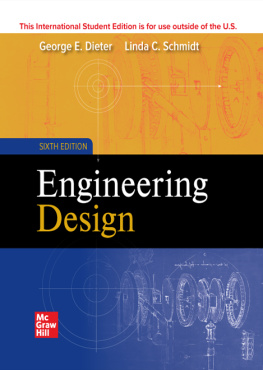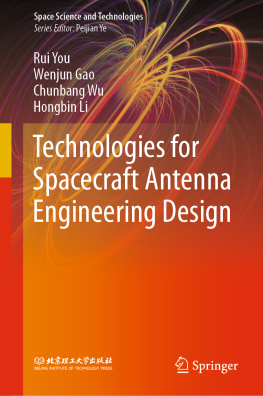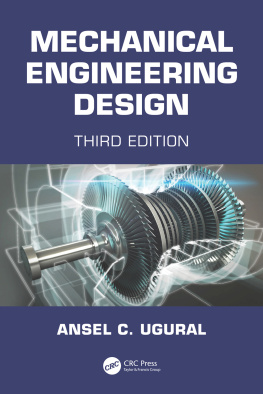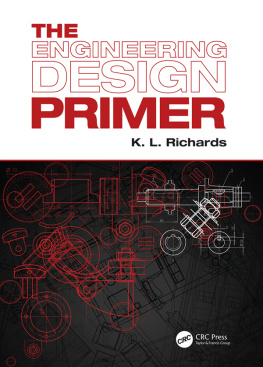
Page i
Engineering Design
sixth edition
George E. Dieter
University of Maryland
Linda C. Schmidt
University of Maryland

Page ii

ENGINEERING DESIGN
Published by McGraw Hill LLC, 1325 Avenue of the Americas, New York, NY 10121. Copyright 2021 by McGraw Hill LLC. All rights reserved. Printed in the United States of America. No part of this publication may be reproduced or distributed in any form or by any means, or stored in a database or retrieval system, without the prior written consent of McGraw Hill LLC, including, but not limited to, in any network or other electronic storage or transmission, or broadcast for distance learning.
Some ancillaries, including electronic and print components, may not be available to customers outside the United States.
This book is printed on acid-free paper.
1 2 3 4 5 6 7 8 9 LCR 24 23 22 21 20
ISBN 978-1-260-57527-9
MHID 1-260-57527-6
Cover Image: Prints & Photographs Division, Library of Congress, LCUSZ62-110332
All credits appearing on page or at the end of the book are considered to be an extension of the copyright page.
The Internet addresses listed in the text were accurate at the time of publication. The inclusion of a website does not indicate an endorsement by the authors or McGraw Hill LLC, and McGraw Hill LLC does not guarantee the accuracy of the information presented at these sites.
mheducation.com/highered
Page iii
About the Authors
GEORGE E. DIETER is Glenn L. Martin Institute Professor of Engineering at the University of Maryland. The author received his B.S. Met.E. degree from Drexel University and his D.Sc. degree from Carnegie Mellon University. After a stint in industry with the DuPont Engineering Research Laboratory, he became head of the Metallurgical Engineering Department at Drexel University, where he later became Dean of Engineering. Professor Dieter later joined the faculty of Carnegie Mellon University as Professor of Engineering and Director of the Processing Research Institute. He moved to the University of Maryland in 1977 as professor of Mechanical Engineering and Dean of Engineering, serving as dean until 1994.
Professor Dieter is a fellow of ASM International, TMS, AAAS, and ASEE. He has received the education award from ASM, TMS, and SME, as well as the Lamme Medal, the highest award of ASEE. He has been chair of the Engineering Deans Council, and president of ASEE. He is a member of the National Academy of Engineering. He also is the author of Mechanical Metallurgy, published by McGraw-Hill, now in its third edition.
LINDA C. SCHMIDT is a Professor in the Department of Mechanical Engineering at the University of Maryland. Dr. Schmidts general research interests and publications are in the areas of mechanical design theory and methodology, design generation during conceptual design, design rationale capture, and effective student learning on engineering project design teams.
Dr. Schmidt completed her doctorate in Mechanical Engineering at Carnegie Mellon University and B.S. and M.S. degrees from Iowa State University. Dr. Schmidt is a recipient of the 1998 U.S. National Science Foundation Faculty Early Career Award. She co-founded RISE, a summer research experience that won the 2003 Exemplary Program Award from the American College Personnel Associations Commission for Academic Support in Higher Education. Dr. Schmidt earned the American Society of Engineering Educations 2008 Merryfield Design Award.
Page iv
Dr. Schmidt is active in engineering design theory research and teaching engineering design to third- and fourth-year undergraduates and graduate students in mechanical engineering. She has coauthored a text on engineering decision-making, two editions of a text on product development, and a team-training curriculum for faculty using engineering student project teams. Dr. Schmidt was the guest editor of the Journal of Engineering Valuation & Cost Analysis and has served as an Associate Editor of the ASME Journal of Mechanical Design. Dr. Schmidt is a Fellow of ASME, and a member of SME and ASEE.
Page v
Brief Contents
Chapter 15 Design for Sustainability and the Environment www.mhhe.com/dieter6e
Chapter 16 Design with Materials www.mhhe.com/dieter6e
Chapter 17 Economic Decision Making www.mhhe.com/dieter6e
Chapter 18 Legal and Ethical Issues in Engineering Design www.mhhe.com/dieter6e

Page vi
Page vii
Detailed Contents
Page viii
Page ix
Page x
Page xi
Chapter 15 Design for Sustainability and the Environment(www.mhhe.com/dieter6e)
15.1 The Environmental Movement
15.2 Sustainabilty
15.3 Challenges of Sustainability for Business
15.4 End-of-Life Product Transformations
15.5 Role of Material Selection in Design for Environment
15.6 Tools to Aid Design for the Environment and Sustainability
Page xii
15.7 Summary
New Terms and Concepts
Bibliography
Problems and Exercises
Chapter 16 Design with Materials (www.mhhe.com/dieter6e)
16.1 Introduction
16.2 Design for Brittle Fracture
16.3 Design for Fatigue Failure
16.4 Design for Corrosion Resistance
16.5 Design Against Wear
16.6 Design with Plastics
16.7 Summary
New Terms and Concepts
Bibliography
Problems and Exercises
Chapter 17 Economic Decision Making (www.mhhe.com/dieter6e)
17.1 Introduction
17.2 Mathematics of Time Value of Money
17.3 Cost Comparison
17.4 Depreciation
17.5 Taxes
17.6 Profitability of Investments
17.7 Other Aspects of Profitability
17.8 Inflation
17.9 Sensitivity and Break-Even Analysis
17.10 Uncertainty in Economic Analysis
17.11 Benefit-Cost Analysis
17.12 Summary
New Terms and Concepts
Bibliography
Problems and Exercises
Chapter 18 Legal and Ethical Issues in Engineering Design (see www.mhhe.com/dieter)
18.1 Introduction
18.2 The Origin of Laws
18.3 Contracts
18.4 Liability
18.5 Tort Law
18.6 Product Liability
18.7 Protecting Intellectual Property
18.8 The Legal and Ethical Domains
18.9 Codes of Ethics
Page xiii
18.10 Solving Ethical Conflicts
18.11 Summary
New Terms and Concepts
Bibliography
Problems and Exercises
Content Available on the Online Learning Center (www.mhhe.com/dieter6e)
Team Organization and Duties
Team Contract
Suggestions for Dealing with People Problems in Teams
Example of TQM Tools
Reading a Patent
Copyrights
Some Notes on Free-Body Diagrams
Axiomatic Design
Decision Theory
Decision Trees
Utility Theory
Shot-Buddy Example
Computer Modeling
Simple Model for Finite Model Analysis
Types of Finite Elements and Steps in FEA Process
A Parametric Design Example: Helical Coil Compression Spring
Shape Factors in Materials Selection
Material Selection for Eco-Attributes
Example: Material Substitution
Brief Descriptions of Manufacturing Processes
Next page








